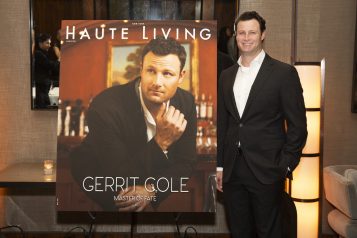Then, about three years ago, something amazing happened: the market for Chinese Contemporary art exploded, much as it had for the American Modernists. “When the economy of a country starts to explode, the inhabitants buy their own culture,” he explains. “When I was in China, I was one of five true art collectors from around the globe collecting this type of art. Now pieces are selling for more than a million dollars!”
With a laugh, Farber says, “My wife, Patricia, says someday my tombstone will say, ‘He got there first!'” Having both the American Modernist and Contemporary Chinese art explode on such a global scale has been good for Farber’s soul. “It makes you feel your beliefs are validated; it makes you feel like what you believe in happened. That doesn’t always happen, and it can’t happen all the time.”
With this in mind, Farber headed into yet another uncharted territory: Contemporary Cuban art, which he classifies as anything that was created after the fall of the Soviet Union, and their subsequent pull-out of Cuba. Many of the Cuban artists scattered around the globe, leaving some of their prized possessions in their homeland. “I went on some ‘Art: Search and Rescue’ missions,” explains Farber, as he journeyed into the island nation to collect pieces that had been left behind.
What he found in his journeys was a vibrant nation filled with art that is reflective of the complex living system of Cuba. In fact, many of the artists did not have the materials necessary to create the pieces. “They would go into an abandoned house and take pieces of chairs to make a wooden sculpture. To me, that shows an intensity and a desire to create, to continue to use what little has been given,” he says.
The result of Farber’s recent amassment of Cuban art is Cuba Avant-Garde: Contemporary Art from The Farber Collection, which will be on display at the Harn Museum of Art in Gainseville, Florida from May 29th through September 9th, 2007, at which time it will begin an international tour. The exhibition features art from the 1980’s through today, with a total of 72 pieces from 42 artists. The pieces, which come in virtually every medium, are “free of prejudice insofar as politics, subjects, genres, or media are concerned,” as explained by Magda González-Mora Alfonso in the book that is accompanying the museum tour.
“I feel like I am really serving a purpose by putting this collection together, because it is a part of history. After the revolution, nobody here really knows what was created in Cuba. There is a whole period of time that is just missing!” Farber exclaims.
In all, the collection is education about the art form: “Some people I have given this book to have said, ‘I thought Cuban art was about cigars and guitars.’ That is not it at all; these are highly creative artists who were not born with silver spoons on their palates. They worked hard, they struggled to create their art, and they did so without government approval.”
In the end, Farber hopes this exhibition will travel the globe, educating people about the art form. He explains, “I think Cuba, in the not-so-distant future, will become very important.” Based on Farber’s track record, art collectors should take note.





















